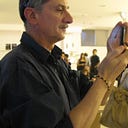Female noun
It would be easy to dismiss it with a joke: video art is a feminine noun. And with this everything was said. But obviously the question is not so simple. During the previous five meetings, we talked about various issues that affect the world of video art, but not by chance we held for the last meeting a theme so broad, and so open: because upstream of everything — or downstream, if you prefer — there is a question that is hard to answer, and this is a way to conclude but not to close the Macro-scopio cycle. Why is video art so rich in female presence?
Until all modern art, art — and especially the visual arts — has been considered as an eminently masculine activity; very few are the artists who managed to pierce this cultural wall, asserting themselves for their abilities and despite gender bias. With contemporary art, this wall has at least become thinner, and the female presence in the arts has grown considerably. However, apart from perhaps the performative art, there is no visual art that records such a significant presence of artists as video art; and significant not only quantitatively, but also qualitatively. In my fortnightly festival experience, I can witness how often the most interesting jobs are those produced by women. Just to try to give numbers, out of ten editions of Magmart, and then 300 selected videos, 95 are those made by women.
Personally I think this is in fact a marginal question. Art, as such, is ungender, has no sex. Obviously, each artist brings his own personal identity into his work, including that of gender, but I do not think that this has a greater relevance than the other elements that make us what we are. At least, not in artistic work.
So the point is not if and what is the sense of such a massive female presence in video art, or if and how to characterize it. Bill Viola could very well be Mary Viola, it would not change anything.
However, the fact remains that this presence is, in fact, very significant. There will be a reason, but I doubt we will find it at the end of this conversation. This fact gives us the ease to observe the videoartic language under this particular perspective.
Which is not exactly a peregrine idea; a few years ago, the National Museum of Women in the Arts in Washington, D.C., created an exhibition dedicated to the radical bodies without which video art would never have been the same. Called “Total Art: Contemporary Video”, the exhibition told women artists from the 60s to today. In particular, the exhibition focused on the work of Janaina Tschäpe, Dara Birnbaum, Kimsooja, Mariko Mori, Mwangi Hutter, Alex Prager, Pipilotti Rist, Michal Rovner, Margaret Salmon and Eve Sussman. But already from the origins it was recorded such presence: Steina Vasulka is among the pioneers of video art, and the same Dara Birnbaum experimented with found footage since the ‘60s.
If the artistic language is ungender, does the artistic (female) video production have its own specificity? Does it have its own connotation?
Ignoring the author, is it possible to deduce from a video what is the genre of the artist who made it? If the answer was yes, it should be ensured that the criterion is valid also for men, and therefore the video art made by men has its own specificity. Which seems to me far-fetched.
After all, I like to think that the correlation between video art and the female world is in fact due to the fact that video art is the most contemporary art form, more firmly related to the languages of the present, and that therefore this significant presence is null other than a manifestation of female protagonism, the current ability of women to read and interpret change much better than men.
And art has always been the language that anticipates times.
